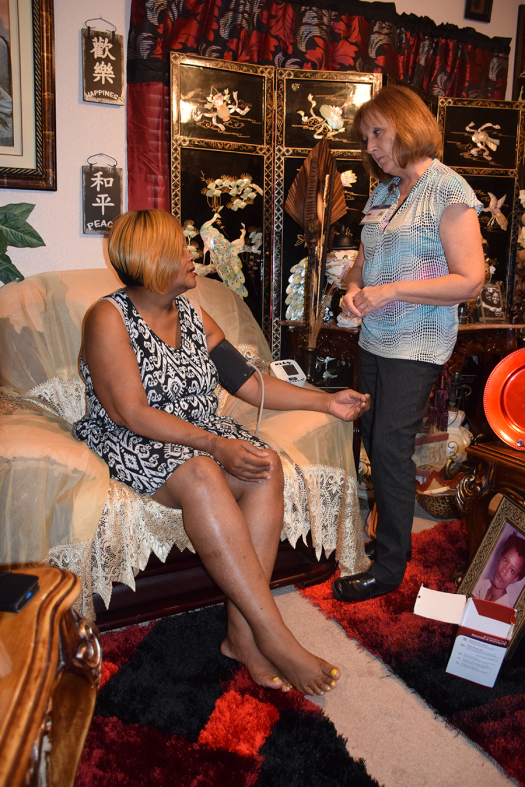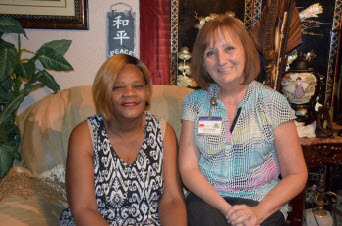 Mary Chambers checks her blood pressure and talks to Vicki Cappa about disease management.
Mary Chambers checks her blood pressure and talks to Vicki Cappa about disease management.Sixty-four-year-old Mary Chambers can pinpoint the exact moment in February that changed her life.
“It was when I received a phone call from Miss Vicki—she’s my hero,” said Chambers, who lives in La Marque.
Chambers is referring to UTMB’s Vicki Cappa, RN, a care manager with the Community Health Program.
UTMB created CHP as a pilot program in 2007, in response to overcrowding in the emergency department. The program aimed to divert people from the ED and get them into a more appropriate care setting by providing care management and disease management services in Galveston to uninsured patients with chronic illnesses such as diabetes, hypertension and heart disease.Thanks to the Section 1115 Medicaid Waiver, the CHP expanded in 2012 to also reach patients in Brazoria County and provide services for Medicare/Medicaid patients, in addition to the uninsured.
Chambers’ name was passed along to CHP staff after she landed in the ED at John Sealy Hospital in Galveston with dangerously high blood sugar levels and a Type 2 diabetes diagnosis. Chambers had known she was sick for years, but didn’t know what was wrong. She had been suffering from debilitating leg swelling and pain, and although she had Medicare, she had trouble navigating the system and felt like she was dismissed without getting any answers.
Barely able to walk, she was confined to her apartment, jobless and hopeless.
“My apartment was like a coffin,” said Chambers. “I stayed in bed for weeks at a time, because I hurt so bad. I had just gone through a divorce and my mother died. I felt totally lost and was at my wits’ end.”
Cappa was just who Chambers needed. Shortly after the initial phone call seven months ago, Cappa made a visit to Chambers’ apartment to help her start managing her diabetes, and the trust was built.
“Miss Vicki was the first person to actually listen to me. Just talking to her, I felt so much better—I wanted to live and knew I had hope,” said Chambers. “She gave me endless encouragement, saying ‘If you do this, this is what will happen. If you do the work, you’ll see the reward.’ I needed someone to tell me what I needed to do, how I would do it and what the results were going to be. And she did that.”
In addition to Cappa’s home visits, she accompanied Chambers to doctor appointments and stayed in touch by phone whenever Chambers had a question or needed support.
“We work really closely with our patients and get to know them very well,” said Cappa. “When you walk into someone’s home, that’s a whole diff erent relationship. It’s a close working relationship, but it’s what it takes to manage these chronic diseases. They are not managed in a 15-minute doctor visit. We do education all the time by phone or in person, answer any questions patients have, give them blood pressure machines, weight scales and other tools and teach them how to use them, find funding for procedures if a patient is uninsured, help them apply for free medications, and more. You name it, we try to do it.”
To help manage her eating habits, Joshalyn Toliver, a community health worker with CHP, met Chambers at her local grocery store to shop aisle by aisle, comparing food labels and showing her how to select appropriate foods to help control diabetes. She also attended a diabetes management class and chronic disease support group offered by CHP.
With the support of Toliver and Cappa, Chambers stayed committed to changing her lifestyle—eating right, taking insulin and seeing a primary care provider on a regular basis. The hard work paid off . She’s down from three shots of insulin a day to one, has lost weight and can walk without a hitch.
“Mary has listened, she has soaked in everything that we have given her and she has run with it,” said Cappa. “I’m so very proud of her.”
 Chambers calls Cappa her "hero."
Chambers calls Cappa her "hero."Chambers isn’t the only person who has benefitted from the program, which helps about 500 people a year—there are other similar stories, says Alison Glendenning-Napoli, UTMB’s director of Outpatient Care Management. She points to a specific patient who went back to work after spending years in and out of the hospital with diabetes and high blood pressure, and another with multiple chronic conditions whose health care costs decreased from $477,574 prior to CHP to $97,133 during CHP because of reduced hospital admissions.
Data her team has collected since the start of the program has shown a 29 percent decrease in inpatient admissions and a 35 percent reduction in costs associated with inpatient utilization. At the same time, CHP has achieved success in improving appropriate health system utilization by increasing outpatient clinic visits during enrollment in the program. More than 50 percent of patients have experienced improved clinical outcomes. These results are significant considering chronic diseases are responsible for seven of 10 deaths each year, and treating people with chronic diseases accounts for 86 percent of our nation’s health care costs, according to the Centers for Disease Control and Prevention.
“Patients who are successful with this program have a high level of involvement and take responsibility for his or her own condition,” said Glendenning-Napoli. “We take the care to the patient and provide the tools, but 90 percent of what patients have to do to manage their disease takes place at home. It’s what you eat, your activity level, it’s all those things. There’s probably as many unsuccessful attempts as successful ones, but when we get those big successes, it’s just huge.”
Chambers isn’t looking back. She has now gained confidence in managing her own health and hopes to soon be off insulin completely.
“I feel better. I can see down the road. I couldn’t see a block ahead before. Isn’t that something?”
1115 MEDICAID WAIVER

The Community Health Program is just one of many programs funded under the Texas Healthcare Transformation and Improvement Program, referred to as the 1115 Medicaid Waiver, which was granted to Texas in 2011. The waiver encourages health care providers to collaborate on innovative solutions to achieve the “triple aim” of health care: improving the patient experience, improving the health of populations and reducing the per capita cost of care, with a special emphasis on Medicaid and uninsured patients. Providers submit their proposed projects to Texas Health and Human Services and the Center for Medicare and Medicaid Services for approval before implementation and earn incentives for successful outcomes.
The state is divided into 20 regions, with UTMB serving as the anchor for Region 2. Region 2 comprises 16 counties with 14 performing providers, working collaboratively to implement 83 projects valued at more than $300 million. Part of UTMB’s role as the anchor institution is to serve as the liaison between regional providers and Texas Health and Human Services.
For more information, go to www.utmb.edu/1115.